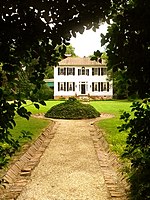Hampton Pinckney

Hampton Pinckney is a neighborhood and national historic district located in Greenville, South Carolina. One of the oldest neighborhoods in Greenville, it was where the textile industry was started in the early 19th century and lasted until the 1920s. The first trolley car in Greenville was installed in this neighborhood in 1899, opening for business in 1901. It encompasses 70 contributing buildings in a residential section of Greenville. The houses date from about 1890 to 1930, and include Italianate, Greek Revival, Queen Anne, various bungalows, and examples of Gothic Revival and Colonial Revival design, as well as vernacular forms. The oldest house in the district is the McBee House (ca. 1835).It was added to the National Register of Historic Places in 1977, with a boundary increase in 1982.
Excerpt from the Wikipedia article Hampton Pinckney (License: CC BY-SA 3.0, Authors, Images).Hampton Pinckney
Hampton Avenue, Greenville Downtown
Geographical coordinates (GPS) Address Nearby Places Show on map
Geographical coordinates (GPS)
| Latitude | Longitude |
|---|---|
| N 34.856111111111 ° | E -82.405833333333 ° |
Address
Hampton Avenue 322
29601 Greenville, Downtown
South Carolina, United States
Open on Google Maps









